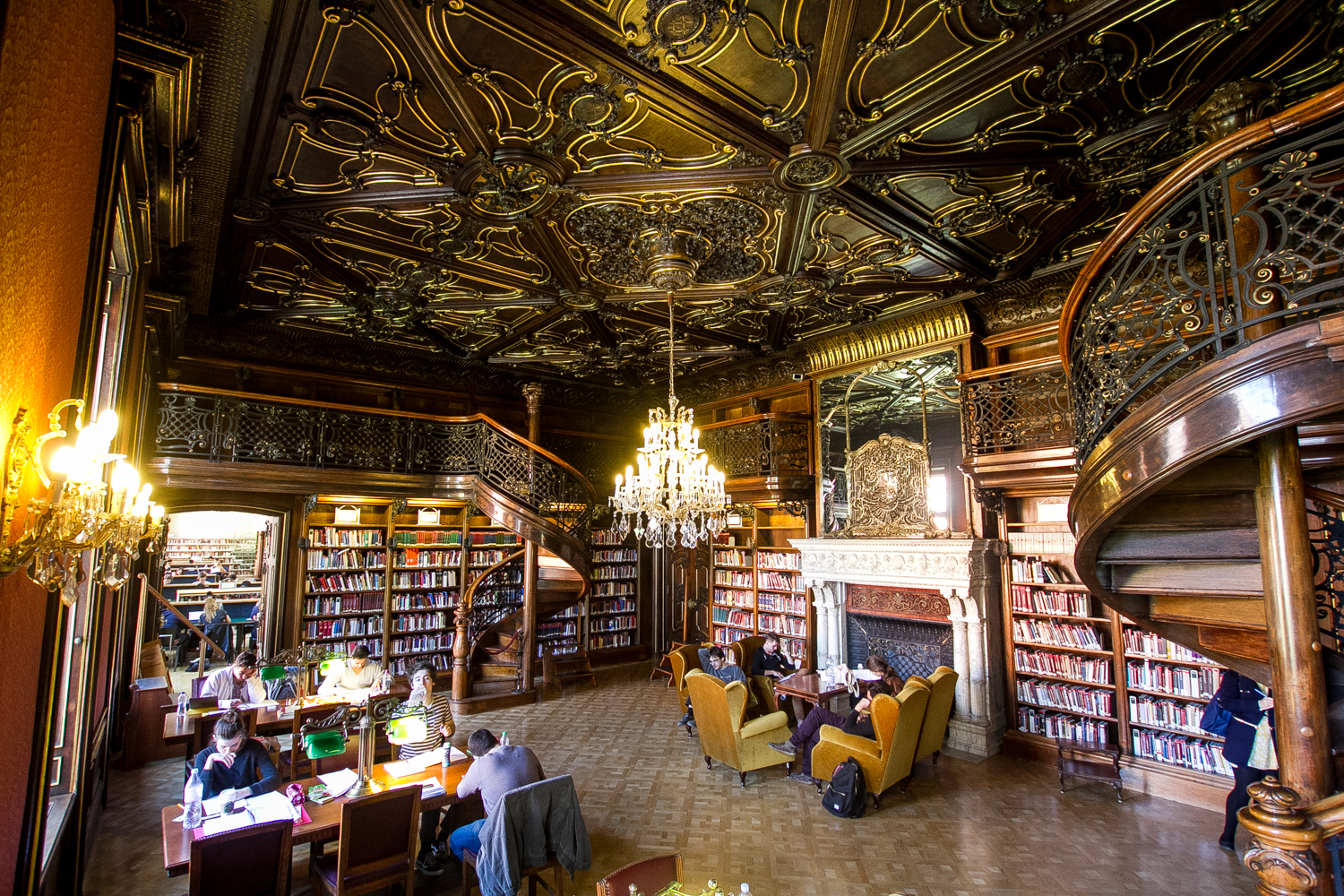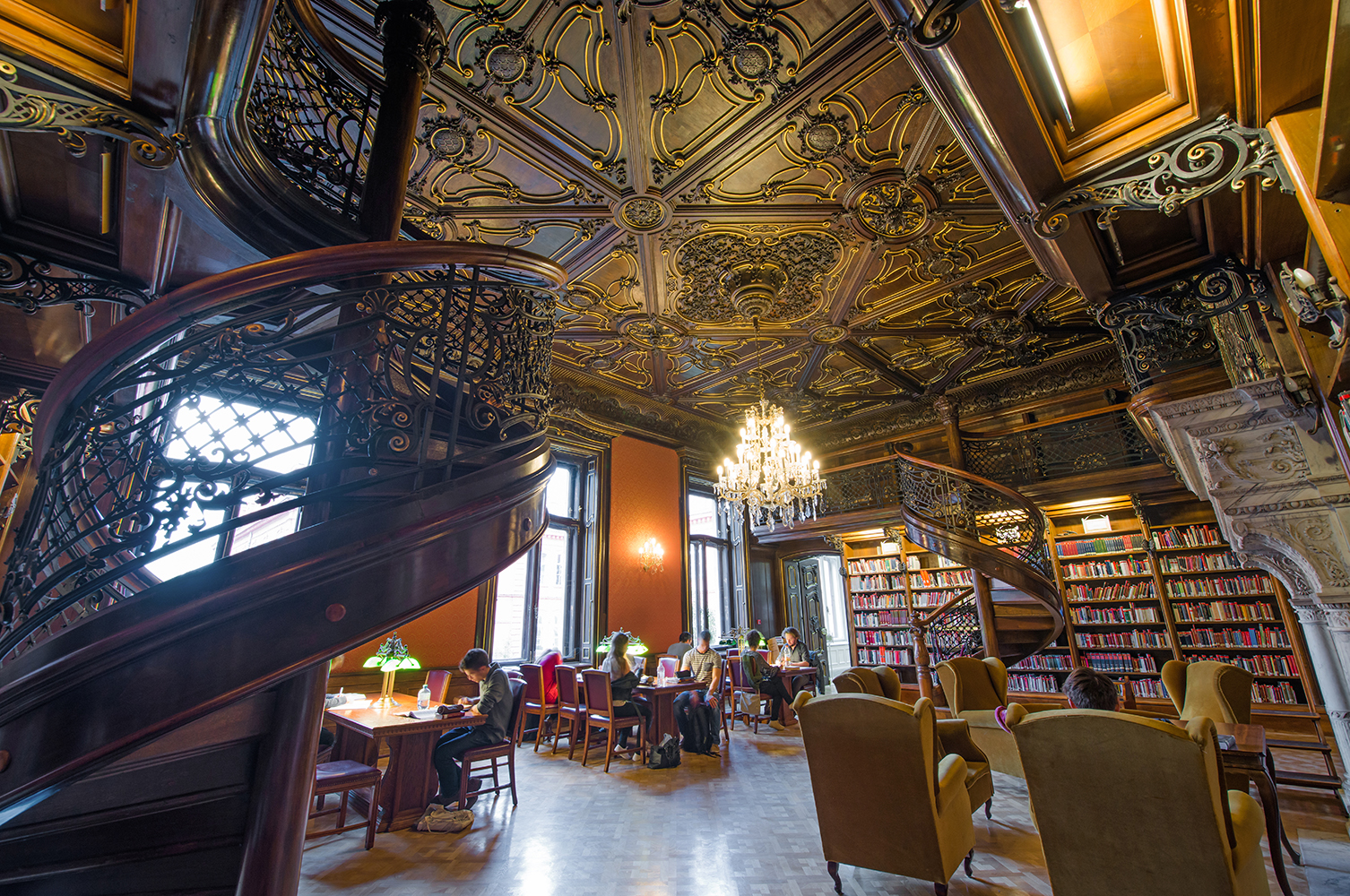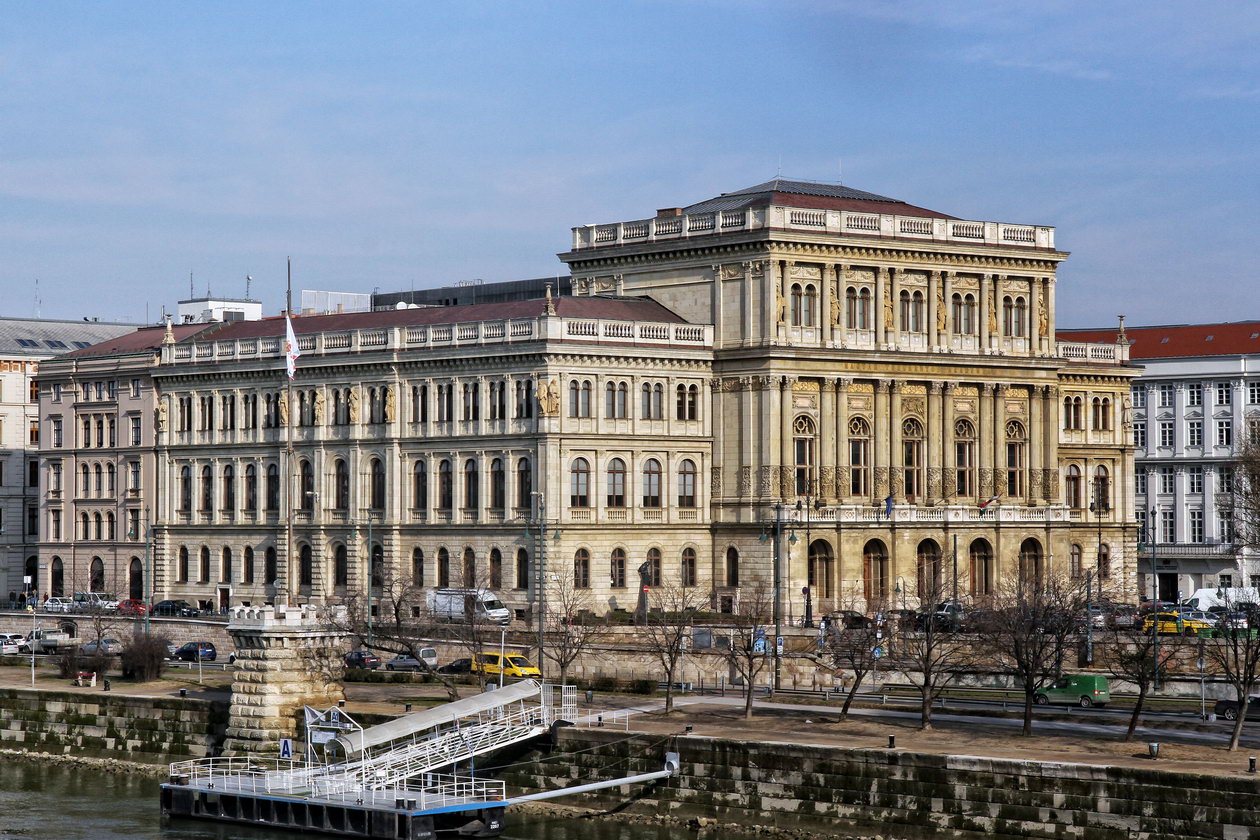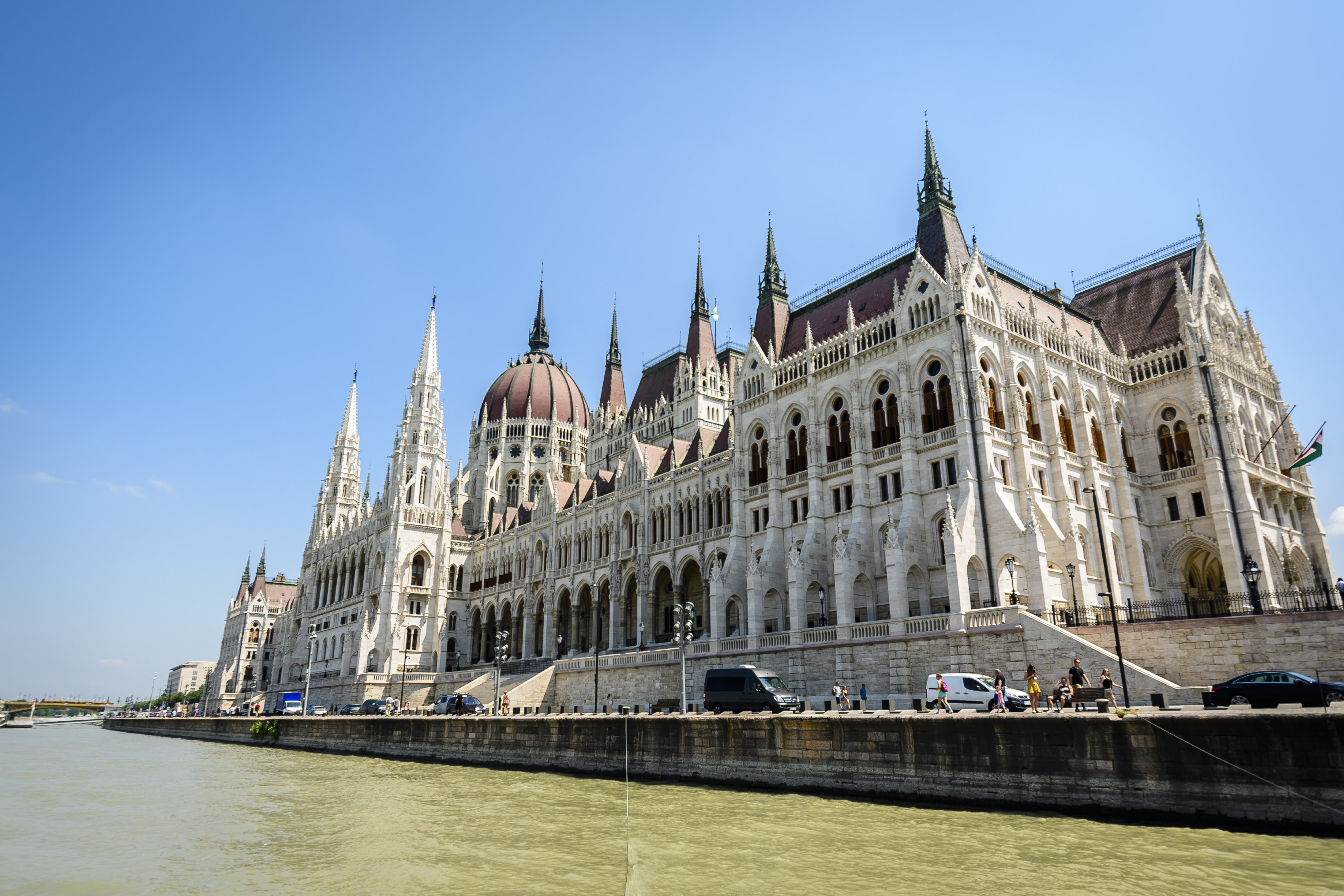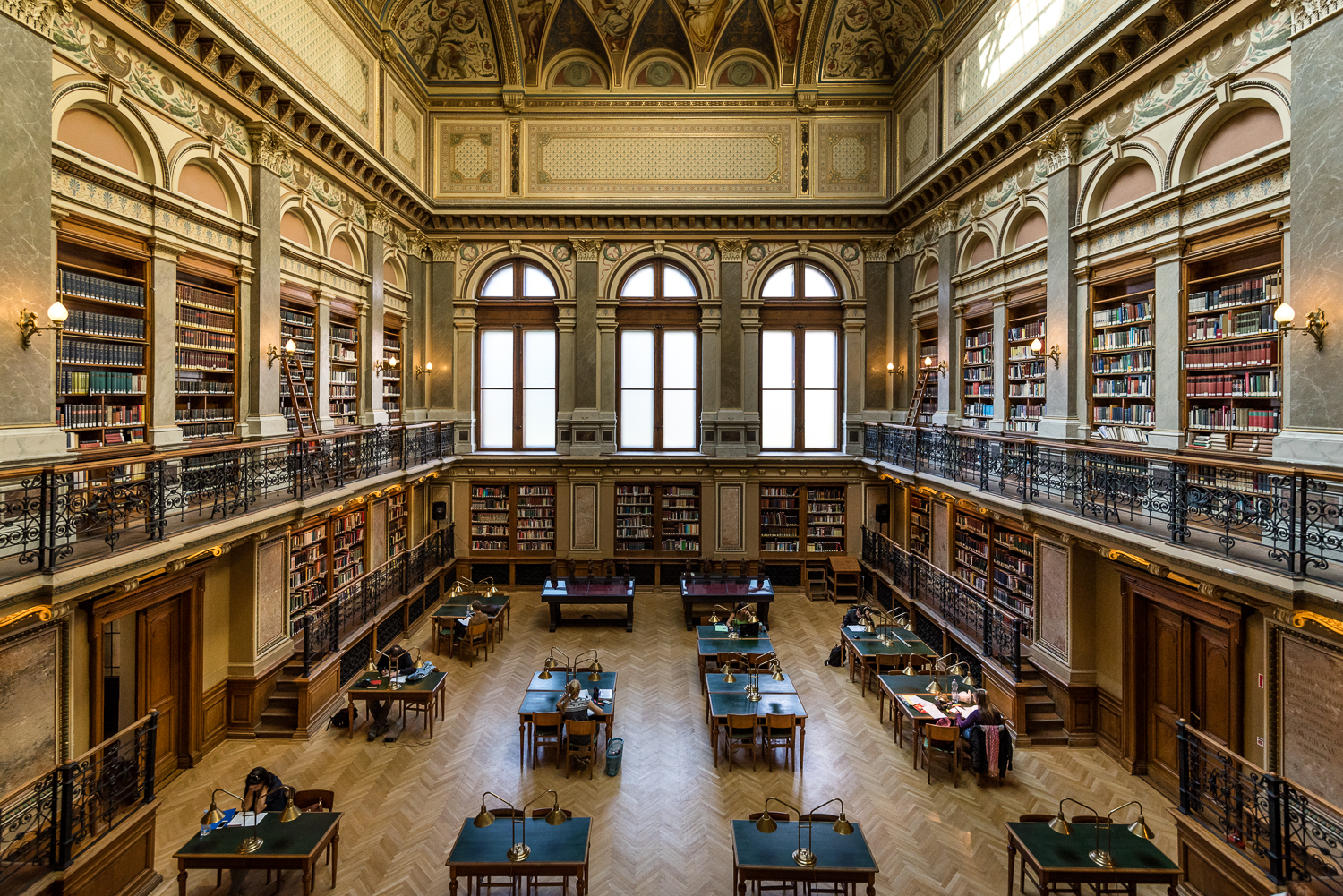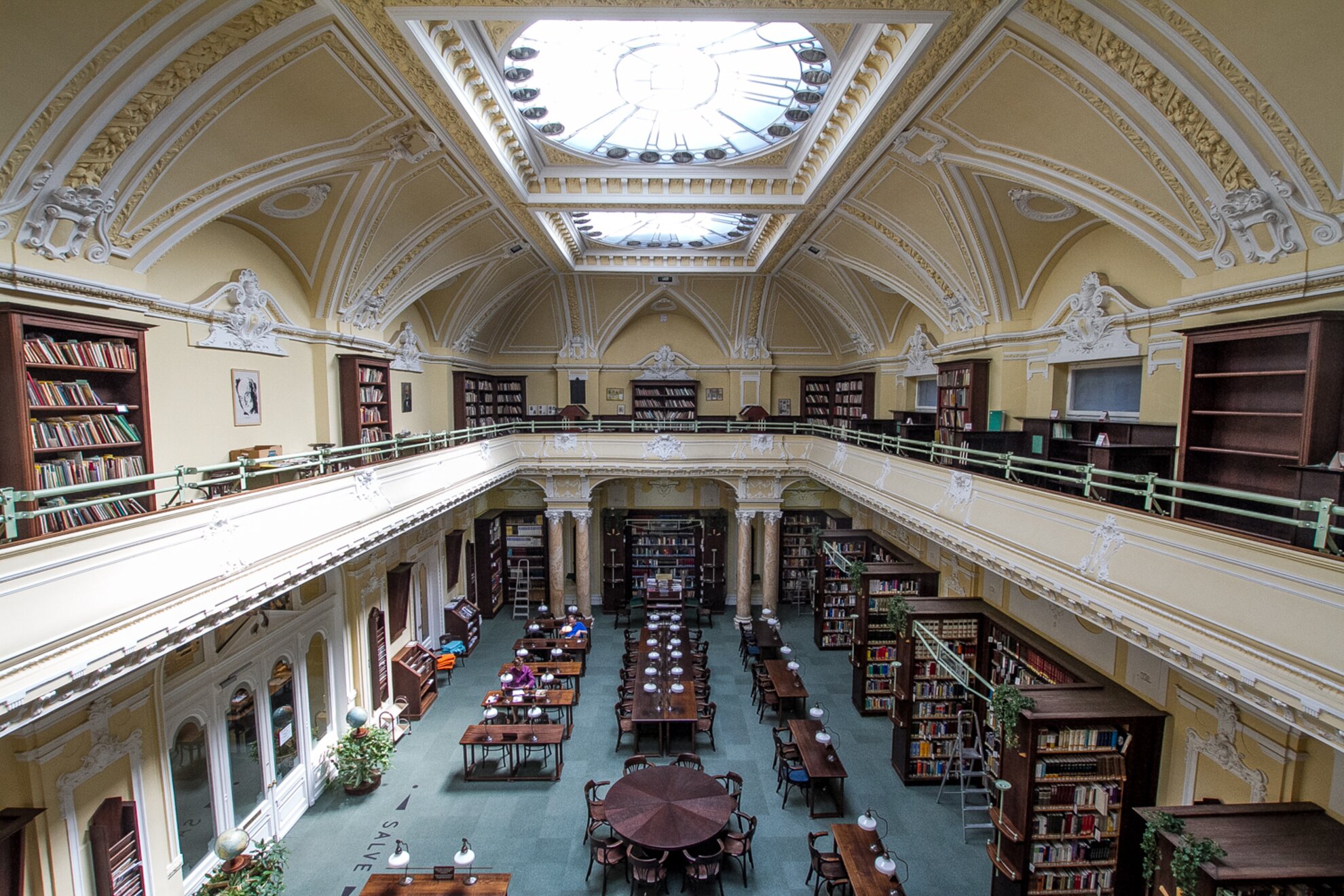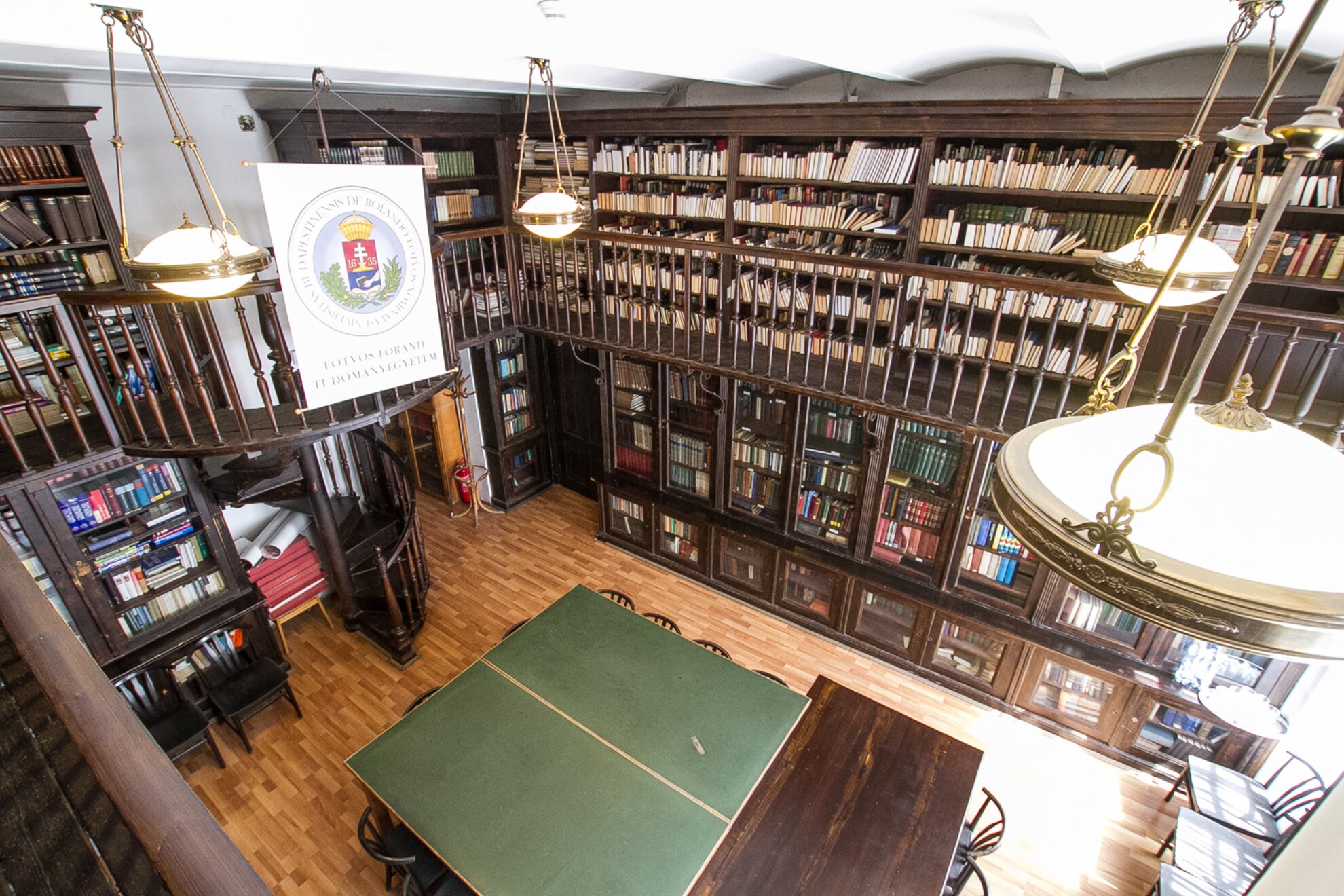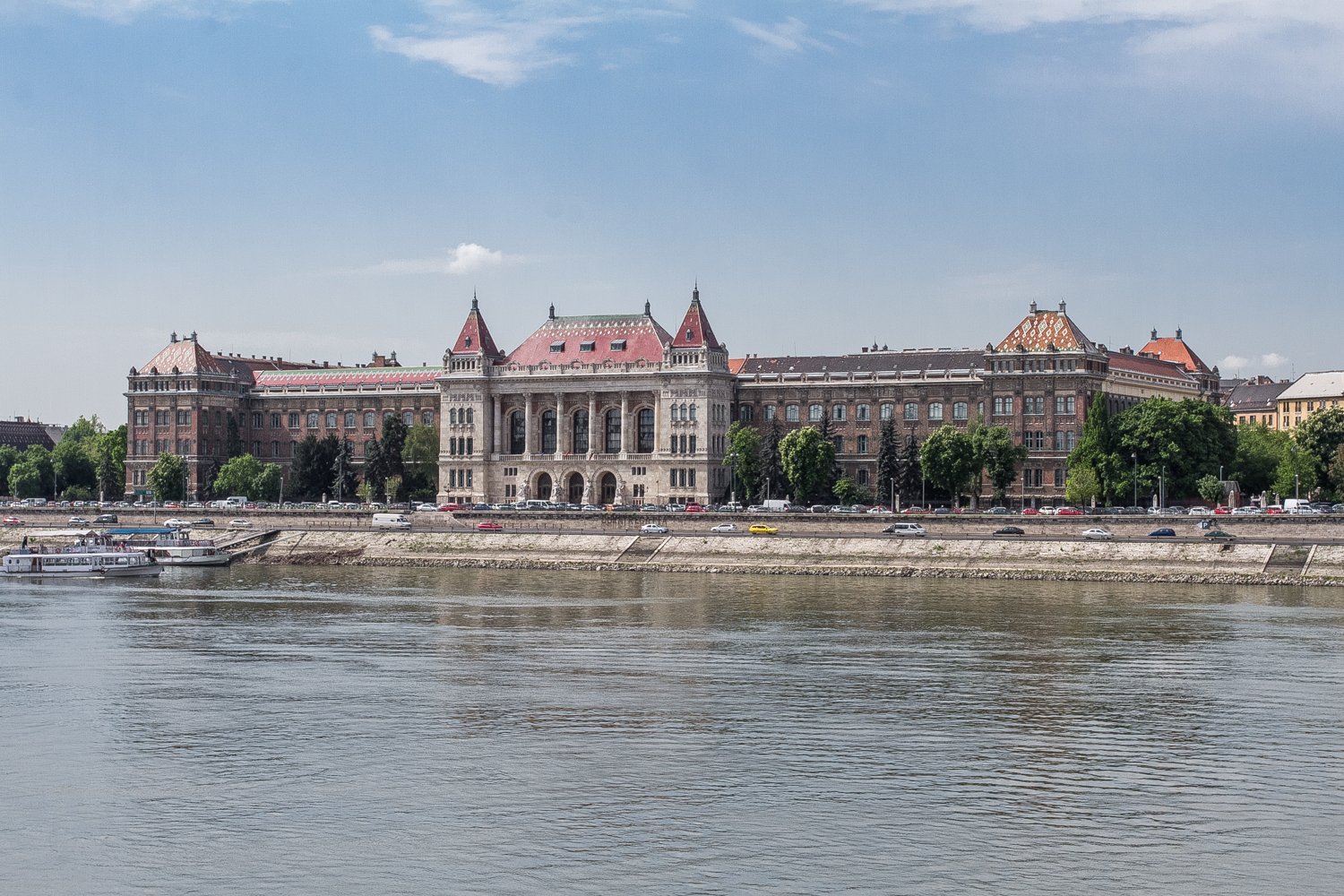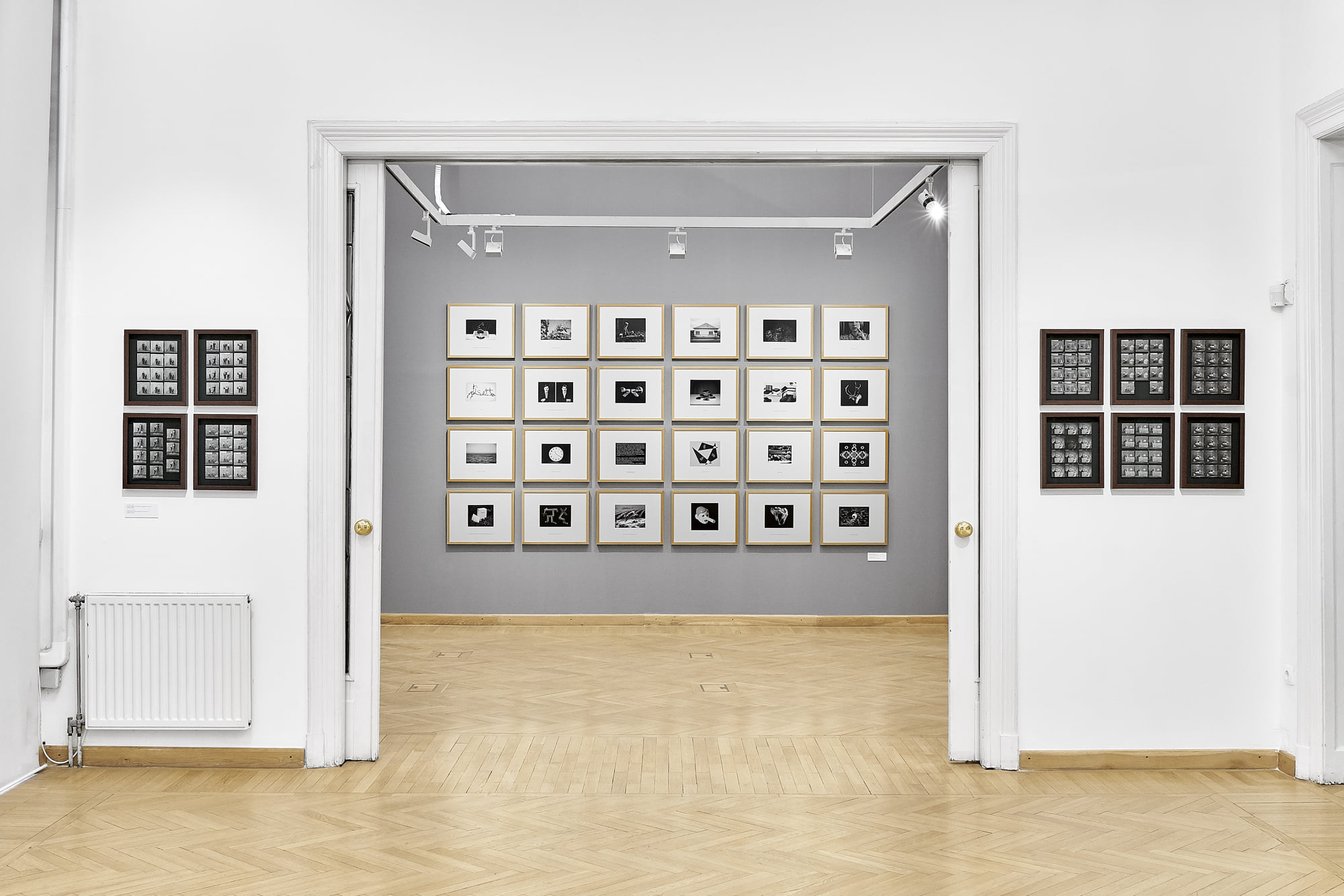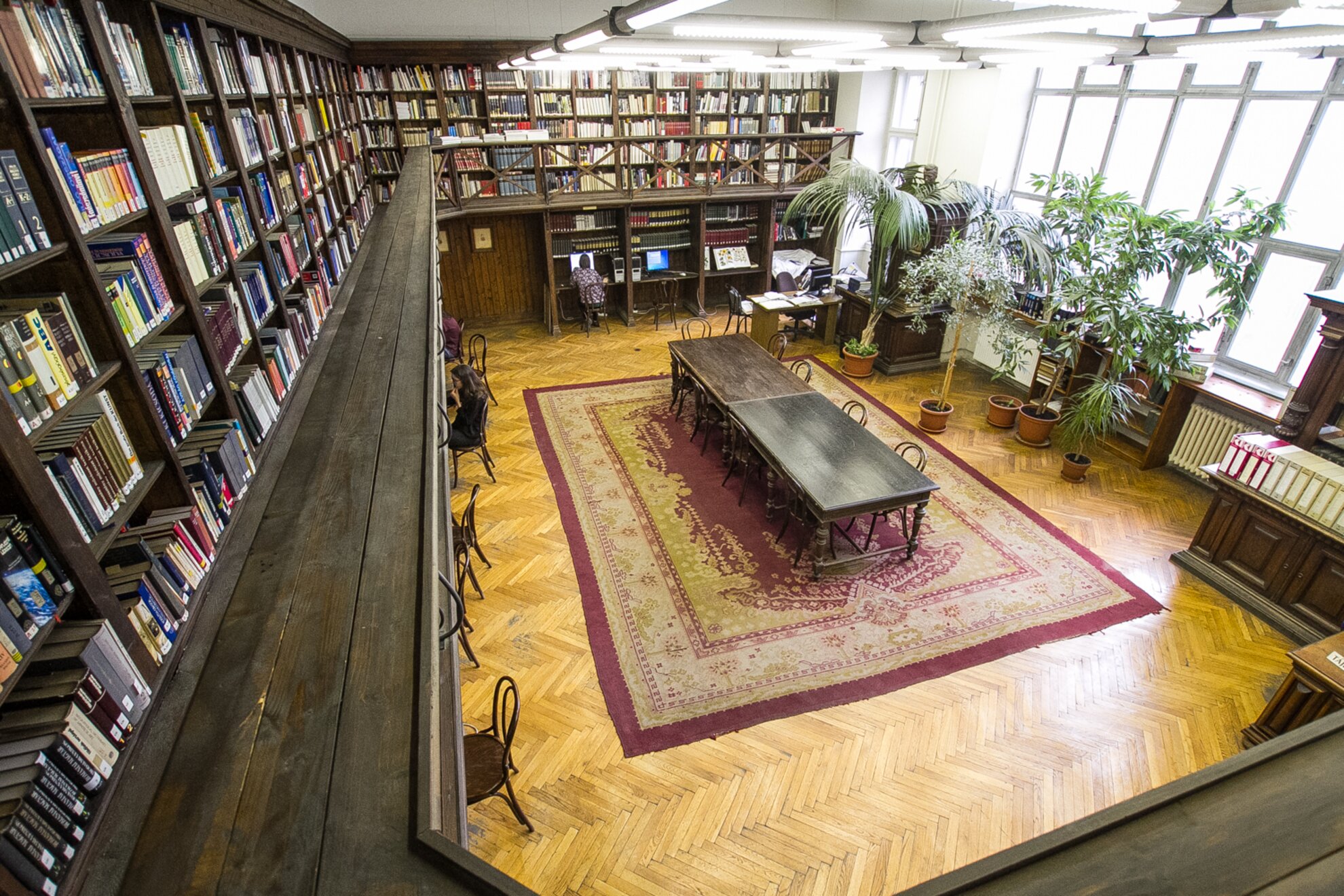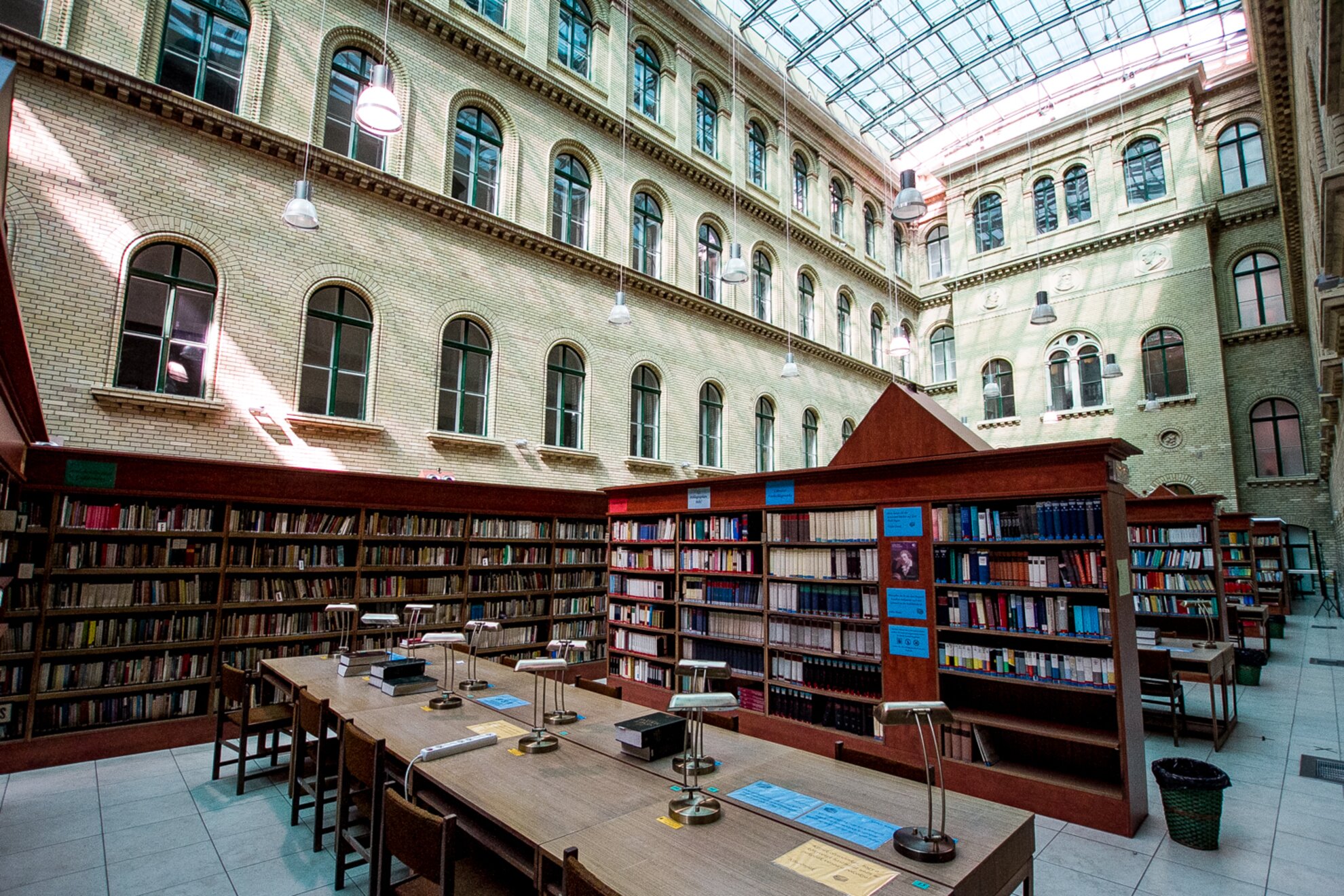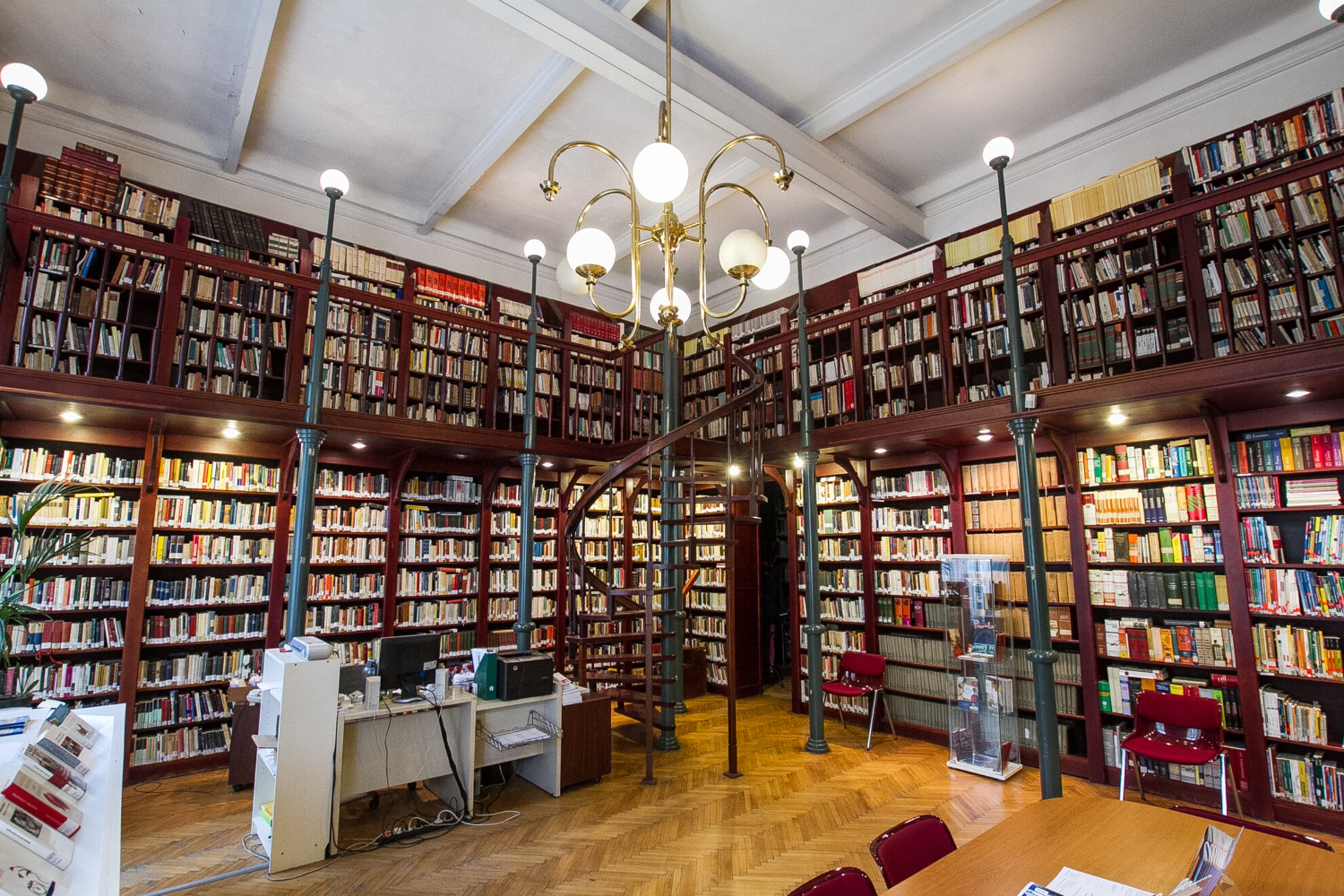Table of Contents
- 1 / 11 - Szabó Ervin Central Library
- 2 / 11 - Library of the Hungarian Academy of Sciences
- 3 / 11 - Library of the Hungarian Parliament
- 4 / 11 - ELTE University Library – Reading Hall
- 5 / 11 - National Library of Foreign Literature
- 6 / 11 - Institute of Slavic and Baltic Philology
- 7 / 11 - The Central Library of BME
- 8 / 11 - Pécsi József Library of Photography
- 9 / 11 - Library of The Hungarian University of Fine Arts
- 10 / 11 - Eötvös Loránd University (ELTE)
- 11 / 11 - Library of The Italian Cultural Institute of Budapest
This library is phenomenal and many don’t know that some of Budapest’s most beautiful reading rooms are open to the public here. This library is housed in what was once the Wenckheim Palace, which was built in the late 1880s to the designs of Artúr Meinig. We start our tour to the right of the main public entrance where we see a fantastic caryatid by sculptor János Fadrusz; these sculpted miners look like they’re holding the entire building on their shoulders. In 1927 the Budapest City Council purchased the Palace, which is a very fine example of Hungarian Neo-Baroque architecture, and in 1931 the library moved in. Although the building suffered damage, huge renovations to the Metropolitan Szabó Ervin Library have restored it beautifully. The reading rooms are of different styles (see images), for example, the dark brown room with a spiral staircase had been a smoker's room when it was still a Palace, while the gold room was originally for the lady of the house (can you spot about six little gold birds on the ceiling?), the silver room was for the man of the house, while there's also a long ballroom and a special wood-carved room - all of which can be accessed by the public as part of the library. We have to say that these are likely to be some of the world’s most beautiful reading rooms, and if you're looking for something to read, there are more than one million documents in this library's vast collection. It is named after Szabó Ervin, who helped develop the public library system in Budapest. We should note that this library is part of a network of libraries running under the acronym 'FSZEK'.
Address: Budapest 1088, Szabó Ervin Square 1.
Access: It's possible to visit the library by purchasing a visitor's ticket or by registering for membership. They also offer guided tours for a small fee if it's arranged in advance.
There are three reading rooms to note within the Hungarian Academy of Sciences. While the Academy’s main library was established in the 1820s, the library moved into the building on Arany János Street in the 1980s to have more space. The library's design is of a classic style, and the views from some of its windows over the Danube are simply beautiful. The building, which now houses the library, had actually been a block of residential apartments (designed by ) but it was significantly renovated to house the core collection of the Hungarian Academy of Sciences’ library. Among its huge collection, we were able to flip through an original newspaper from 1867 - the Budapest Napló (“Budapest Journal”). The second library of note here is in the Hungarian Academy of Sciences building (accessed via Széchenyi Square) where you can see the Oriental Collection's library. Its reading room dates back to the 1950s and was designed with Islamic motifs in mind. Finally, up the grand staircase of the Academy is another special collections library, this time for the Department of Manuscripts and Rare Books. It looks onto an inner courtyard with a giant tree.
Address: Budapest 1051, Arany János Street 1.
Access: The main library is open to the public, find details here on using the library's facilities. The two special collections libraries have restricted access, details here.
What a stunner! This is certainly one of the most astoundingly beautiful libraries in Hungary. The library is located on the Danube-side of the Parliament, and from within there's a view right onto the river. As you can see on the images there are ornate decorations, ceiling-high shelves of books (the highest of which are accessed via the gallery) and furniture which complements the space perfectly. It's a public library open to those wishing to study or read from its massive collection, just don’t expect to bump into any politicians as they mostly use another library. The library moved in in 1902, and just like the rest of the Hungarian Parliament it was designed by Hungarian architect Imre Steindl. Some of the decorations and motifs in the library match those in the rest of the building, for example the carved roses decorating the ceiling of the library can also be found in the Vadászterem ('Hunter Hall') of the Parliament. The book shelves, window frames and some of the furniture are original from the early 1900s as well. The library's collection includes documents on the topics of law, politics, history, literature and many other areas. There are also special United Nations and European Union collections. One of the things we liked the most is that you can find the historical documents of the Hungarian Parliament dating back to 1580 here! It must be said that this is not just one of the most beautiful, but one of the quietest libraries in Budapest, and it's clear that this library's readers are proud to be able to use such a special space.
Address: Budapest 1055, Kossuth Lajos Square 1-3.
Access: The library doesn’t have the capacity to show walk-ins around the library, however, if you register in advance you can come and quietly look around. Remember you have to submit an ID number and pass security on the way in. Email: registration@ogyk.hu for information. To use the library's facilities get a library card.
The reading hall of the ELTE University Library is nothing short of breathtaking. Located in the heart of Budapest, the whole building is impressive. It was built with a library in mind in 1876 to the plans of Antal Skalnitzky, but it's important to note that the University Library had been operating since much earlier at other locations. This was the first public library in Hungary. The classic reading hall is some 200 square meters and is currently undergoing renovations, but in the near future it will be open to the public to use as a reading hall once more. The frescos here are by Hungarian painter Károly Lotz and depict female figures, symbolic of the sciences and arts. There is a glass roof in the ceiling and three giant windows on one side allowing enormous amounts of natural light to fill the space. The library's collection consists of almost two million documents on topics including history, philosophy, Hungarian literature and psychology. Among the most impressive are the about 180 codexes and 11,000 volumes from the 16th century. We have to mention that the beautiful entry to this library (pictured) is worth seeing in itself!
Address: Budapest 1053, Ferenciek Square 6.
Access: It’s open to the public to view, and guided tours can also be arranged.
Hidden behind an unassuming façade is the beautiful National Library of Foreign Literature, which is slowly but surely being restored to its former glory via a series of renovations. Here you can find books and other resources in more than 100 languages, but it’s worth visiting the reading room whether you’re studying or not. The cream and white decorated hall has a gallery and is a beautiful spot to study quietly. It’s worth paying attention to the frosted glass in the doors and the marble on the walls of the staircases and walkways. Visit the Music Collection area too – it’s a more modern area that’s been renovated in a classic style – you don’t want to miss it. Of the building itself we can say that it dates back to 1897 when the Katholikus Kör ('Catholic Circle') used it. In the 1950s it became the Gorkij State Library, before becoming the National Library of Foreign Literature in 1989.
Address: Budapest 1056, Molnár Street 11.
Access: The public is welcome to look around, although to use the library’s services check these details.
The library of ELTE University’s Institute of Slavic and Baltic Philology is lucky to be in what was once Loránd Eötvös’ personal library. He was a Hungarian physicist who researched and taught at the University of Budapest, which was then renamed the Eötvös Loránd University in 1950. The small library has a gallery and it's lined floor-to-ceiling with books. The beautiful deep brown shelving and wooden spiral staircase are the originals of the turn-of-the-century design. The interior is simple, yet very atmospheric making it one of Budapest's loveliest small libraries. The Institute's library has a vast collection of literature, dictionaries, history and so forth in the Slavic and Baltic languages.
Address: Budapest 1088, Museum Boulevard 4. (Building D)
Access: The library is used for events and by students, however, you can ask to quietly view the reading room if it's not occupied.
The National Technical Information Centre and Library at the Budapest University of Technology and Economics (BME OMIKK) is surely one of Budapest’s most beautiful libraries. Overhead at the entry is the Sóhajok hídja ('Bridge of Sighs'), which is a beautiful sight in itself. The library building, designed by Pecz Samu, was built in the early 1900s. Passing through the central Aula, we reach the famous reading room, which is sometimes used for filming. This is little wonder because it’s very beautiful. The reading room, which has undergone a huge renovation, has big glass windows, a cathedral-esque ceiling and a spacious light-filled interior. While the furniture is a relatively recent purchase it matches the space elegantly. The prime colour, other than cream, is moss green, which is the typical colour palette favoured by many schools and universities. The library's collection includes more than one million books including on the topics of economics, engineering and science.
Address: Budapest 1111, Budafoki Road 4.
Access: It's open to the public to view the space quietly, or you can buy a daily ticket or sign up.
This photography library has operated in the Mai Manó House since 1999, but the building itself dates back to 1893-94. The famous Hungarian photographer Mai Manó lived on the 3rd floor where the library now is. So, as a library, it's not that “old,” however, it’s certainly beautiful and its design matches the style of the entire building. Here you can find all kinds of books on the topic of photography. There is also a terrace, that although you can’t access it, looks onto bustling Nagymező Street. The library has a collection of thousands of items, and you can check out the 150 works they’re most proud of here. The library is called the Pécsi József Library of Photography and is named after a prominent Hungarian photographer.
Address: Budapest 1065, Nagymező Street 20.
Access: The library is open to view, however, to use the library's services and reading rooms there is a free membership requirement. More details here.
Walking along Andrássy Avenue it's easy to miss The Hungarian Academy of Fine Arts, but hidden in one of its wings is the Academy's specialist library. It's certainly one of the most beautiful - if understated - libraries in Budapest. The library furniture itself dates back to 1900, matching the Neo-Renaissance style of the entire building, and still has the original bookshelves and cupboards. As you can see in the photos there's one long room split into three parts with a split level created by the shelves and walkways making the space feel enclosed and secretive - like it's the headquarters of a secret society for wizards! There's also a fourth light-filled reading room as well. One of the points of interest is the library’s archive in which we can find out who taught the alumni of the Academy and who they went to school with. This, of course, is crucial in the arts when considering an artist's master and inspiration. Of the many treasures here, we could mention that it has more than 10,000 old photos plus a rare collection of original Succession-era posters. Another interesting point is that this was one of the first higher education institutions that allowed women to study, yet the library was sectioned off with women's and men's reading rooms before finally allowing mixed-sex use. Nowadays, apparently, the men are campaigning against this because of how distracting the beautiful women can be while they're trying to study!
Address: Budapest 1062, Andrássy Avenue 69-71.
Access: It is open to the public to view and read onsite if you sign up for a membership.
In the inner courtyard of the main ELTE BTK building in the Eötvös Loránd University's Museum Boulevard campus, there are two libraries operating side-by-side under a huge glass roof: the Library of the School of English and American Studies and the Library of the Institute of German Studies. This inner courtyard had been a typical open-air courtyard found in many of Budapest's buildings, and it was once where the entertainment spot Holdudvar (now on Margaret Island) operated. However, because the university needed to find space for the two libraries, in 2006 it converted the courtyard, adding heating from the floor and a huge glass roof overhead. The light-filled space is lined with row-upon-row of shelves, while underground there are many more books in storage waiting to be requested by the readers. The glass roof is covered by a shade cloth in summer to prevent glare. This might just be one of the only libraries in the world that used to be an entertainment spot, and we love it!
Address: Budapest 1088, Museum Boulevard 6-8.
Access: The library is for students, however, you can see it as long as you are quiet and respectful of those studying.
The Italian Cultural Institute of Budapest library also has a nice reading room. While it’s a modern library space, its building has an impressive history; earlier it was the site of the Hungarian Parliament. Although it’s a beautiful and tranquil space, in a historic building, the library's interior is not antique, with the shelving and spiral staircase created in the 1980s. The library itself has a vast selection of Italian books and DVDs, and if you get a chance to visit, it’s worth asking to see the main hall.
Address: Budapest 1088, Bródy Sándor Street 8.
Access: You can visit the library when it's open, but to use the library’s services there's a membership fee.
